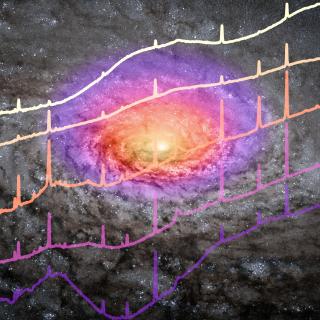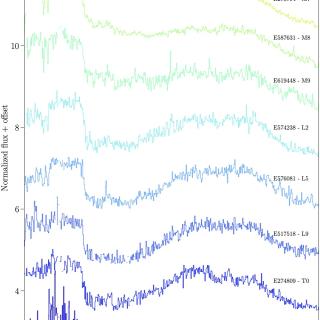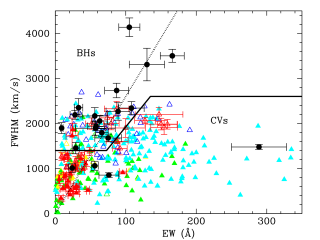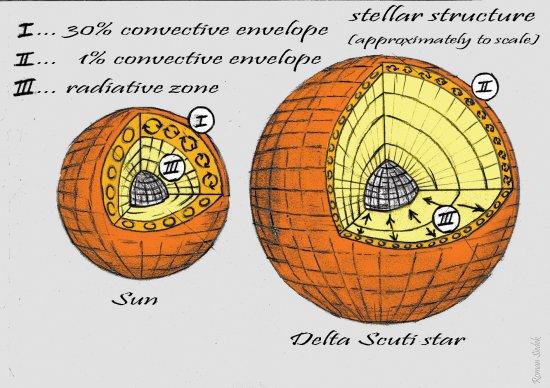Delta Scuti (δ Sct) stars are opacity-driven pulsators with masses of 1.5-2.5M⊙, their pulsations resulting from the varying ionization of helium. In less massive stars such as the Sun, convection transports mass and energy through the outer 30 per cent of the star and excites a rich spectrum of resonant acoustic modes. Based on the solar example, withno firm theoretical basis, models predict that the convective envelope in δ Sct stars extends only about 1 per cent of the radius, but with sufficient energy to excite solar-like oscillations. This was not observed before the Kepler mission, so the presence of a convective envelope in the models has been questioned. Here we report the detection of solar-like oscillations in the δ Sct star HD 187547, implying that surface convection operates efficiently in stars about twice as massive as the Sun, as the ad hoc models predicted.
Advertised on
It may interest you
-
 Type 2 quasars (QSO2s) are active galactic nuclei (AGN) seen through a significant amount of dust and gas that obscures the central supermassive black hole and the broad-line region. Here, we present new mid-infrared spectra of the central kiloparsec of five optically selected QSO2s at redshift z ∼ 0.1 obtained with the Medium Resolution Spectrometer module of the Mid-Infrared Instrument (MIRI) aboard the James Webb Space Telescope (JWST). These QSO2s belong to the Quasar Feedback (QSOFEED) sample, and they have bolometric luminosities of log L bol = 45.5 to 46.0 erg s −1 , global starAdvertised on
Type 2 quasars (QSO2s) are active galactic nuclei (AGN) seen through a significant amount of dust and gas that obscures the central supermassive black hole and the broad-line region. Here, we present new mid-infrared spectra of the central kiloparsec of five optically selected QSO2s at redshift z ∼ 0.1 obtained with the Medium Resolution Spectrometer module of the Mid-Infrared Instrument (MIRI) aboard the James Webb Space Telescope (JWST). These QSO2s belong to the Quasar Feedback (QSOFEED) sample, and they have bolometric luminosities of log L bol = 45.5 to 46.0 erg s −1 , global starAdvertised on -
 The Near-Infrared Spectrometer and Photometer (NISP) on board the Euclid space mission has obtained near-infrared (NIR) spectra of millions of objects, including hundreds of ultracool dwarfs (UCDs). Euclid observations retrieve images and slitless spectra simultaneously. This observing mode marks a new era in the discovery of new objects, such as L- and T-type dwarfs, which can be found from direct identification through the H2O and CH4 absorption bands. NISP spectral resolution (R ∼ 450) is enough to classify the objects by the spectral type using known standard templates. Q1 provided moreAdvertised on
The Near-Infrared Spectrometer and Photometer (NISP) on board the Euclid space mission has obtained near-infrared (NIR) spectra of millions of objects, including hundreds of ultracool dwarfs (UCDs). Euclid observations retrieve images and slitless spectra simultaneously. This observing mode marks a new era in the discovery of new objects, such as L- and T-type dwarfs, which can be found from direct identification through the H2O and CH4 absorption bands. NISP spectral resolution (R ∼ 450) is enough to classify the objects by the spectral type using known standard templates. Q1 provided moreAdvertised on -
 Dormant black holes in X-ray transients can be identified by the presence of broad Hα emission lines from quiescent accretion discs. Unfortunately, short-period cataclysmic variables can also produce broad Hα lines, especially when viewed at high inclinations, and are thus a major source of contamination. Here we compare the full width at half maximum (FWHM) and equivalent width (EW) of the Hα line in a sample of 20 quiescent black hole transients and 354 cataclysmic variables (305 from SDSS I to IV) with secure orbital periods (Porb) and find that: (1) FWHM and EW values decrease with PorbAdvertised on
Dormant black holes in X-ray transients can be identified by the presence of broad Hα emission lines from quiescent accretion discs. Unfortunately, short-period cataclysmic variables can also produce broad Hα lines, especially when viewed at high inclinations, and are thus a major source of contamination. Here we compare the full width at half maximum (FWHM) and equivalent width (EW) of the Hα line in a sample of 20 quiescent black hole transients and 354 cataclysmic variables (305 from SDSS I to IV) with secure orbital periods (Porb) and find that: (1) FWHM and EW values decrease with PorbAdvertised on
